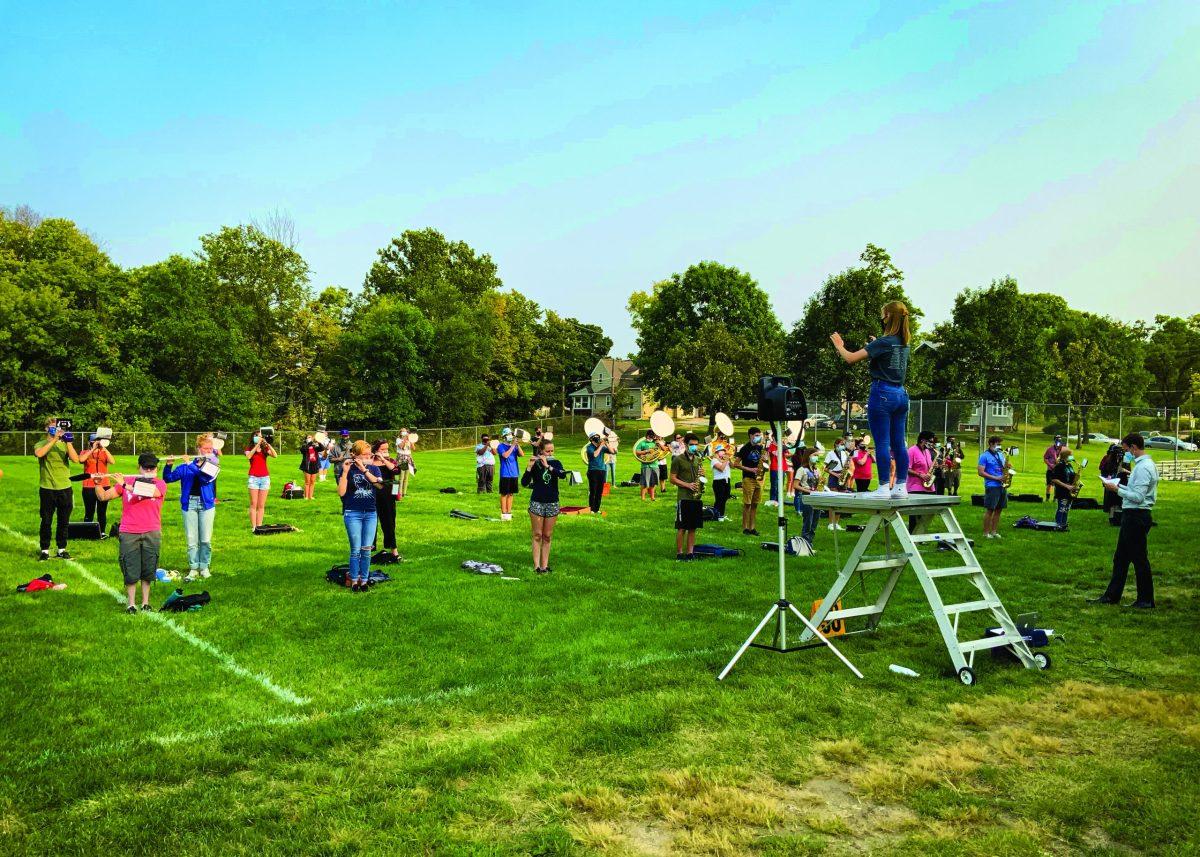While some activities made an easy transition online to comply with coronavirus precautions, there are some programs where this is just not possible. One such program at Drake University is band.
Percussionist Katie Barnhart said that while she chose Drake for its music program, she was not sure that band would even be possible this year due to coronavirus.
“I wasn’t sure if there would be band for most of the summer, but we were told in late summer that we would be trying our best to have band with modifications,” Barnhart said.
Jacob Lish, also a percussionist for Drake, said band was no different than other classes in that students did not know many details about the plan until close to the start of the school year.
“Much like the rest of my classes, everything was in the air until the date set by the university for professors to let everyone know what the plan for class was,” Lish said. “Music students were sent emails over the summer with all the information needed to ensure a safe and healthy transition back to classes.”
Though the decision was made to continue having band, precautions were put in place to maintain social distancing and avoid the spread of germs.
“We were told that there will be no live concerts, and we would be rehearsing in small groups that were within the capacity of our larger rooms, PPE such as masks (including special masks while playing) and bell covers,” Barnhart said. “We are required to have our own stands and music and as a percussionist, I am only allowed to use my own equipment besides large instruments which we wipe down. We are also wiping down practice rooms, leaving 30 minutes between occupants, and some spaces have air filters.”
According to mellophone player Jayna Lieberman, marching band has now become ‘standing band’ to maintain social distancing.
“Instead of marching around and playing at half time like we usually would, we are standing still and live streaming a performance on Oct. 2,” Lieberman said.
Lieberman said that while she understands the need to meet social distancing requirements, she will miss the ‘marching’ part of marching band.
“There are good and bad things about it,” Lieberman said. “Since we’re just standing, we can focus more on the musicality of the performance and not have to worry about where we are on the field or keeping our steps in time. But I also miss being able to move around and having an actual show/concept to portray was one of my favorite things about marching band.”
Barnhart said she agrees with the decision to have the band stand in place rather than march during performances.
“I don’t mind the change to standing band because I am part of the front ensemble section which doesn’t march, and I think it was the right choice for maintaining constant distance,” Barnhart said.
However, Lish said he remains unclear about how standing is more socially distant than marching.
“I am still somewhat confused about this, to be honest,” Lish said. “I don’t really understand why standing in one place is better than moving around. In fact, I feel like I am standing closer to others than I ever did last year.”
For brass players like Lieberman, there are some special rules in place to prevent virus spread through spittle.
“We’ve had to get masks with slits in them, bell covers, and for brass players we needed to get a container to hold our spit in instead of emptying it on the floor,” Lieberman said.
However, the need for the special masks for brass players has created a new issue: band members across the country are scrambling to get masks and the supply is short.
“I personally have not gotten mine yet; since everyone is trying to order them, the online stores are backordered,” Lieberman said. “In the meantime, I’ve gotten a disposable mask and cut a slit in the middle so that I can still play. It is a little more challenging because especially in marching band, we need to quickly put our horns up and down and it’s really hard to do without either accidentally ripping the mask off with the mouthpiece or missing the hole and not being able to start playing in time.”
Lieberman said that in some ways, the changes have been beneficial; because the band does not need to worry about practicing the marching aspect, they are able to have their performance earlier in the year.
“Obviously, no one wanted to just get rid of band altogether,” Lieberman said. “Since we don’t need as much time to learn drill and get the sets lined up with music, we are able to have a performance sooner than we usually would in the year. Also, because we don’t have as much to learn and we’ll have a sooner performance, then we are able to start concert band sooner, which I personally like better.”
There was a COVID scare when one of the members of the drumline tested positive for coronavirus, leading the rest of the drumline to quarantine.
“As a member of the drumline, I can say that after an indoor rehearsal (because of the rain), one of our members was contacted and told they tested positive for COVID-19 by the university as a part of the random testing initiative,” Lish said. “They were asymptomatic, which is why they decided to come to class in the first place. Everyone in the room was wearing masks and we were distanced the same way as on the field, but the contact tracing team thought it best to have everyone who attended the rehearsal quarantine in their room, if on campus, or in their off-campus housing.”
However, the show will go on, and the band performance is still planned for Oct. 2 at 4:30 p.m. Viewers can tune in at that time at https://youtu.be/csuz65mpG6I.







